Showing Spotlights 121 - 128 of 547 in category All (newest first):
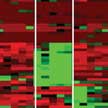 When nanoparticles enter the blood stream or other biological fluids, they are quickly surrounded by a layer of proteins. This so-called protein corona on the nanoparticles hinders interactions between the targeting ligands on the nanoparticles and their binding partners on the cells' surface. Different individuals may have a personalized protein corona owing to their distinct type, severity and period of disease, heterogeneity, individual genetic variations and environmental factors. By combining the concepts of disease-specific protein corona and sensor array technology, researchers now have created a label-free platform for the early detection and identification of diseases.
When nanoparticles enter the blood stream or other biological fluids, they are quickly surrounded by a layer of proteins. This so-called protein corona on the nanoparticles hinders interactions between the targeting ligands on the nanoparticles and their binding partners on the cells' surface. Different individuals may have a personalized protein corona owing to their distinct type, severity and period of disease, heterogeneity, individual genetic variations and environmental factors. By combining the concepts of disease-specific protein corona and sensor array technology, researchers now have created a label-free platform for the early detection and identification of diseases.
Jun 17th, 2019
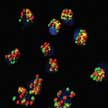 A critical challenge in gene therapy is the safe and effective delivery of genetic materials across cell membranes into target cells. Although viral systems have been the most effective method for delivering genetic matter into cells, they pose significant safety problems. Demonstrating a novel alternative delivery vector, researchers have developed a facile one-pot strategy to encapsulate plasmid DNA into nanoscale metal-organic frameworks (MOFs) and a MOF-polymer system Experiments showed that pDNA molecules could be well distributed throughout the MOF nanostructures and benefited from effective protection against the enzymatic degradation.
A critical challenge in gene therapy is the safe and effective delivery of genetic materials across cell membranes into target cells. Although viral systems have been the most effective method for delivering genetic matter into cells, they pose significant safety problems. Demonstrating a novel alternative delivery vector, researchers have developed a facile one-pot strategy to encapsulate plasmid DNA into nanoscale metal-organic frameworks (MOFs) and a MOF-polymer system Experiments showed that pDNA molecules could be well distributed throughout the MOF nanostructures and benefited from effective protection against the enzymatic degradation.
Jun 13th, 2019
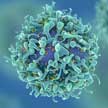 The use of TiO2 nanoparticles activated by light and ultrasound has been studied extensively for cancer treatments. For the first time, researchers have shown the nanoparticles can be effectively activated by microwaves for cancer cell destruction - potentially opening new doors for patients fighting cancer. They propose the use of microwaves and TiO2 nanoparticles to induce the production of reactive oxygen species (ROS), which has the potential to be a safer, more effective modality for cancer treatment.
The use of TiO2 nanoparticles activated by light and ultrasound has been studied extensively for cancer treatments. For the first time, researchers have shown the nanoparticles can be effectively activated by microwaves for cancer cell destruction - potentially opening new doors for patients fighting cancer. They propose the use of microwaves and TiO2 nanoparticles to induce the production of reactive oxygen species (ROS), which has the potential to be a safer, more effective modality for cancer treatment.
May 30th, 2019
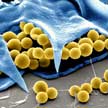 New work on self-propelled biohybrid microrobots has been inspired by recent developments of biohybrid cyborgs that integrate self-propelling bacteria with functionalized synthetic nanostructures to transport materials. Taking inspiration from the science fiction concept of a cybernetic organism, or cyborg, researchers developed a self-propelled biohybrid microrobot, named rotibot, employing the marine microorganism rotifer as their engine.
New work on self-propelled biohybrid microrobots has been inspired by recent developments of biohybrid cyborgs that integrate self-propelling bacteria with functionalized synthetic nanostructures to transport materials. Taking inspiration from the science fiction concept of a cybernetic organism, or cyborg, researchers developed a self-propelled biohybrid microrobot, named rotibot, employing the marine microorganism rotifer as their engine.
Apr 3rd, 2019
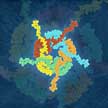 Alpha-synuclein is a protein whose function in the healthy brain is currently unknown. It is of great interest to Parkinson's researchers because it is a major constituent of Lewy bodies, protein clumps that are the pathological hallmark of Parkinson's disease (PD). Scientists believe that the self-assembly of alpha-synuclein into oligomers and fibrils is linked to progress and pathogenesis of the disease. A new study suggest that important characteristics of the fibrillation process, such as surface charge and surface functional group, should be considered in the development of nanotechnology-based therapeutic approaches.
Alpha-synuclein is a protein whose function in the healthy brain is currently unknown. It is of great interest to Parkinson's researchers because it is a major constituent of Lewy bodies, protein clumps that are the pathological hallmark of Parkinson's disease (PD). Scientists believe that the self-assembly of alpha-synuclein into oligomers and fibrils is linked to progress and pathogenesis of the disease. A new study suggest that important characteristics of the fibrillation process, such as surface charge and surface functional group, should be considered in the development of nanotechnology-based therapeutic approaches.
Mar 19th, 2019
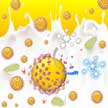 Nanoparticles that mimic the complexity and function of natural enzymes can act as effective peroxidase to catalyse for the oxidization of 3,3,5,5-tetramethylbenzidine (TMB), generating an oxidised blue-coloured product. For the first time scientists found that when the surface of gold nanoparticle (AuNPs) is coated with casein, the intrinsic peroxidase-mimicking activity of AuNPs is suppressed strongly, i.e. by up to 77.1%, due to the surface shielding effects.
Nanoparticles that mimic the complexity and function of natural enzymes can act as effective peroxidase to catalyse for the oxidization of 3,3,5,5-tetramethylbenzidine (TMB), generating an oxidised blue-coloured product. For the first time scientists found that when the surface of gold nanoparticle (AuNPs) is coated with casein, the intrinsic peroxidase-mimicking activity of AuNPs is suppressed strongly, i.e. by up to 77.1%, due to the surface shielding effects.
Dec 6th, 2018
 The idea has been around for a while that selected segments of RNA or DNA could be used therapeutically to affect gene or cell function. The attraction for researchers is the flexibility that these therapeutic nucleic acids' (TNAs) versatility, programmability, and modularity affords them and shows a promising route towards treatment for a wide variety of disorders such as cancer, metabolic disorders, viral infections, cardiovascular and inflammatory diseases. Due to the programmability of RNA and DNA, scientists now are able to embed functional assemblies with controllable immunogenic potential into nucleic acid-based nanoparticles to eliminate the immune response and control the timing of their therapeutic activation.
The idea has been around for a while that selected segments of RNA or DNA could be used therapeutically to affect gene or cell function. The attraction for researchers is the flexibility that these therapeutic nucleic acids' (TNAs) versatility, programmability, and modularity affords them and shows a promising route towards treatment for a wide variety of disorders such as cancer, metabolic disorders, viral infections, cardiovascular and inflammatory diseases. Due to the programmability of RNA and DNA, scientists now are able to embed functional assemblies with controllable immunogenic potential into nucleic acid-based nanoparticles to eliminate the immune response and control the timing of their therapeutic activation.
Dec 5th, 2018
 Researchers investigated the potentially protective role of nanoceria against oxidative stress associated with microgravity and cosmic radiations in space. Their findings support the application of antioxidant nanomaterials to skeletal muscle tissue culture for protection from the noxious effects of microgravity and cosmic radiations, which result in muscle mass and force loss and limit human operations and permanence in space. On Earth, these deteriorations are usually associated with aging or pathologies and are exhibited over longer time intervals compared to those occurring in space.
Researchers investigated the potentially protective role of nanoceria against oxidative stress associated with microgravity and cosmic radiations in space. Their findings support the application of antioxidant nanomaterials to skeletal muscle tissue culture for protection from the noxious effects of microgravity and cosmic radiations, which result in muscle mass and force loss and limit human operations and permanence in space. On Earth, these deteriorations are usually associated with aging or pathologies and are exhibited over longer time intervals compared to those occurring in space.
Oct 29th, 2018
 When nanoparticles enter the blood stream or other biological fluids, they are quickly surrounded by a layer of proteins. This so-called protein corona on the nanoparticles hinders interactions between the targeting ligands on the nanoparticles and their binding partners on the cells' surface. Different individuals may have a personalized protein corona owing to their distinct type, severity and period of disease, heterogeneity, individual genetic variations and environmental factors. By combining the concepts of disease-specific protein corona and sensor array technology, researchers now have created a label-free platform for the early detection and identification of diseases.
When nanoparticles enter the blood stream or other biological fluids, they are quickly surrounded by a layer of proteins. This so-called protein corona on the nanoparticles hinders interactions between the targeting ligands on the nanoparticles and their binding partners on the cells' surface. Different individuals may have a personalized protein corona owing to their distinct type, severity and period of disease, heterogeneity, individual genetic variations and environmental factors. By combining the concepts of disease-specific protein corona and sensor array technology, researchers now have created a label-free platform for the early detection and identification of diseases.
 Subscribe to our Nanotechnology Spotlight feed
Subscribe to our Nanotechnology Spotlight feed





